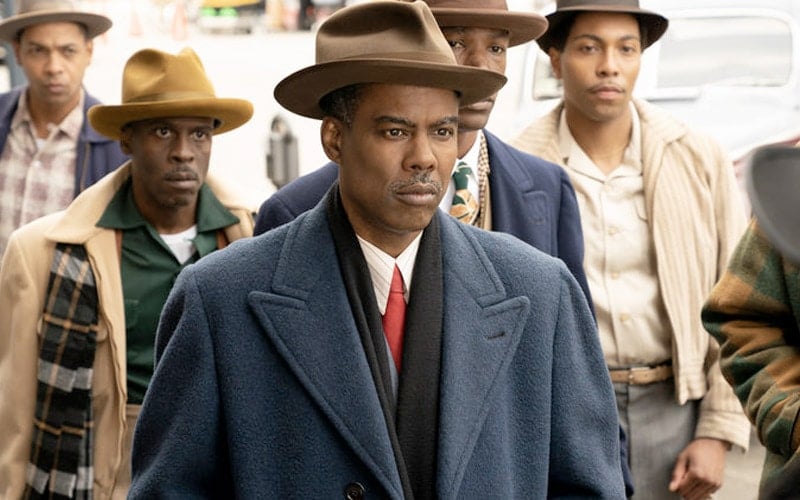‘Fargo’ Season 4 Review: The Results of Racism & Xenophobia

Spoilers Below
Fargo Season Four, created by Noah Hawley, wrestles with racism, xenophobia, and the unraveling of the myth that crime families are romantic in any way. The season occurs in 1950’s Kansas City and follows two prominent crime families. We have the African American crime syndicate called Cannon Limited, led by Loy Cannon (Chris Rock), and the Sardinian Fadda Family, who’s new Don is the Italian American Josto Fadda (Jason Schwartzman). These two crime syndicates are vying for absolute power in the Kansas City underworld.
Josto Fadda and Loy Cannon dismantle the myth that these crime syndicates are all about family loyalty. Fargo shows how little these men value their families from the very beginning of the story.
In the 1920s, to stop any significant gang wars, the bosses of The Jewish Moskowtiz Syndicate and The Irish Milligan Concern traded their young sons. Gangsters from all sorts of families did the same kind of trade from the 1930s to the 1950s.
Loy’s youngest son Michael “Satchel” Cannon, is traded with Justo’s youngest brother Zero Fadda. Neither Loy nor Josto cares enough about their young immediate family members to make a deal that doesn’t put them in danger to maintain peace. Both crime organizations consider, at least once, killing one of the young boys, showing a lack of regard for innocent lives.
Finally, Ebal Violante, Consigliere to the Fadda Family, executes Josto and his lover Oraetta (a nurse whose an angel of mercy), thinking Josto had the nurse kill his father, Don Donatello Fadda. Violante also believes that Josto murdered his little brother Gaetano Fadda.
The consigliere views Josto as power-hungry. And while Josto gladly took over Don’s position after his father died, he did not order Oraetta to smother Donatello. He didn’t assassinate Gaetano, but both brothers vied for control of the “Family” for the most season. Both Josto and his little brother attempted to kill each other several times. These crime syndicates value money over their flesh and blood.
Season Four has a compelling story but is not as innovative as past seasons. Hawley spoiled audiences in Fargo Season Three with brilliant editing, sound, and cinematography. (The best example of the innovation is in episode four; Bill Bob Thornton narrated Sergei Prokofiev’s “Peter and the Wolf” while everything unravels for the brothers Emmit and Ray.) During this current season, the closest thing to innovation is the all black and white episode nine, “East/West,” where the story centers around Patrick “Rabbi” Milligan and young Satchel escaping the dangerous world of Kansas City. The only problem is that there is no reason why the episode is in black and white, so it took me out of the story. No other episodes had played with color. All of this being said, the enthralling part of Season Four is the narrative, so don’t expect the same insightful production value as previous storylines.
Racism is explored in this series through the actions of Canon Limited. Loy and his Consigliere Doctor Senator operate a Black Bank in their neighborhood partly because it helps them keep control. But there is also a need. No mainstream bank will service African American customers. Loy invents the credit card after realizing that people like to appear wealthier than they are. Credit Cards are being used by Black banks countrywide, but no White store will accept them as payment.
The two Black men pitch the credit cards concept to Mr. Winckle, Winckle Savings & Loans. They want their cards to be used in White society to earn more significant profits. Mr. Winckle refuses the idea because he doesn’t think hard-working Americans would spend money they don’t have. But race plays a part. Winckle refers to Senator and Loy as “boys” when he refuses the deal, even though both men are his age or older. The fact that White stores won’t work with the Black Bank shows how systematic racial prejudice is in the 1950s and even today. Fargo Season Four also points out that the definition of “White” has shifted throughout American history.
Xenophobia is another American problem wrestled with in Season Four. While speaking to his son Josto in their car, young boys shoot Don Fadda in the throat with BB guns. Rabbi and the other gangsters urgently pull over at the nearest private hospital. The hospital administrator Dr. Harvard refuses to save his life because they are not respectable “Americans” (code for Italians) even though most of them were born in the United States. Medical personal should care for any patient no matter their class, criminal record, or ethnicity. If Dr. Harvard had taken Don Fadda as a patient, Nurse Oraetta wouldn’t have euthanized him in the public hospital.
Italians were not considered Americans back in the 1950s. The United States rejected most foreigners or people of color, creating Italian, Jewish, Irish, and Black crime syndicates. These ethnic groups had no lucrative employment opportunities outside of the underworld. But instead of fighting the system that oppressed each of them, these “outsider” gangsters are greedy. Each marginalized group steps on the others’ neck to gain power for themselves, ignoring the immense authority that saw them all as less than “White” Americans.
Season Four is not the best part of the Fargo anthology, but it tackles topical issues and has an engaging story. Hawley subverts the gangster genre like the Coen Brothers do in their films. The casting is perfect, and everybody is on the top of their game. The gangster characters speak Italian bringing a sense of authenticity.


Responses